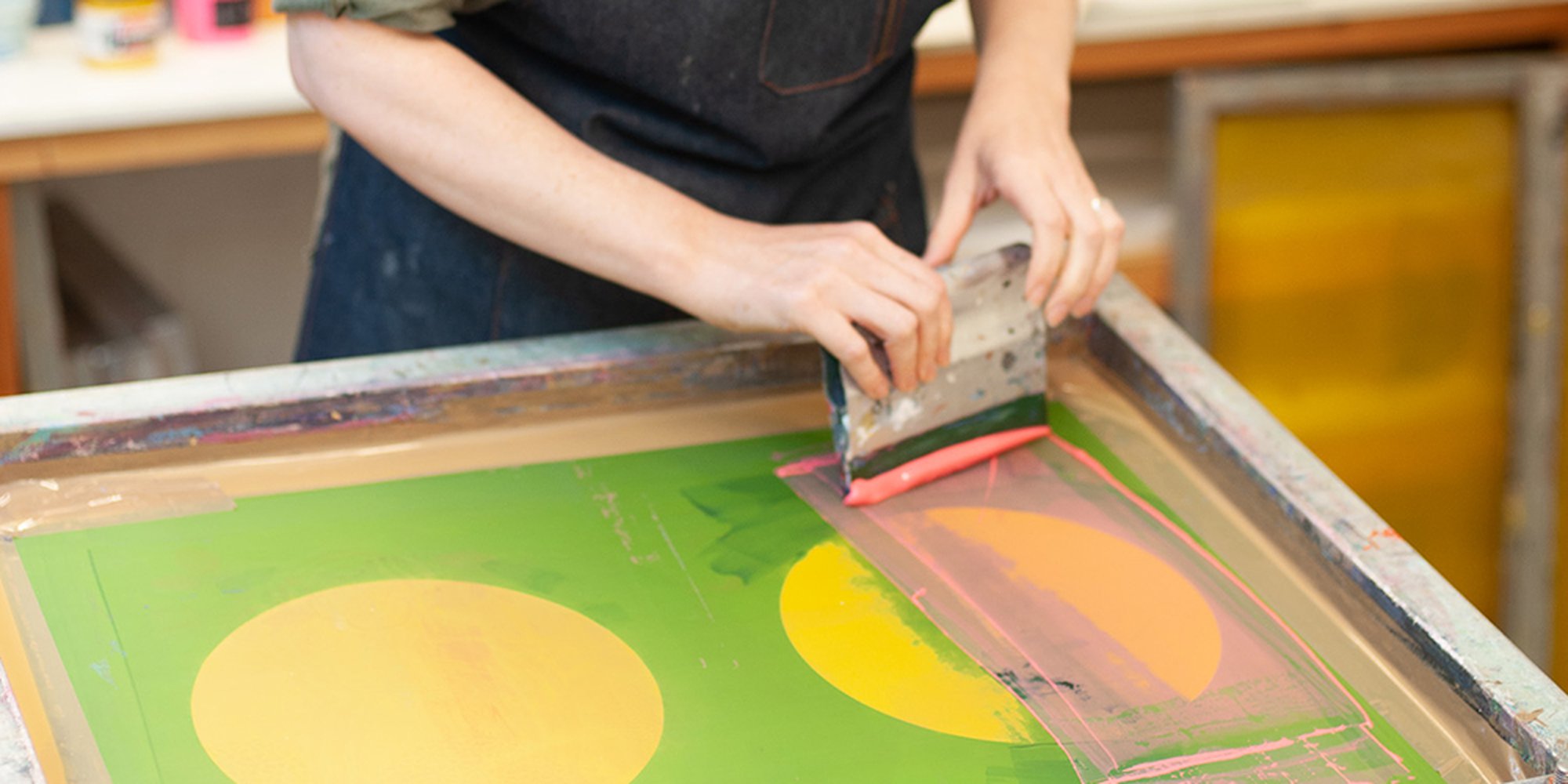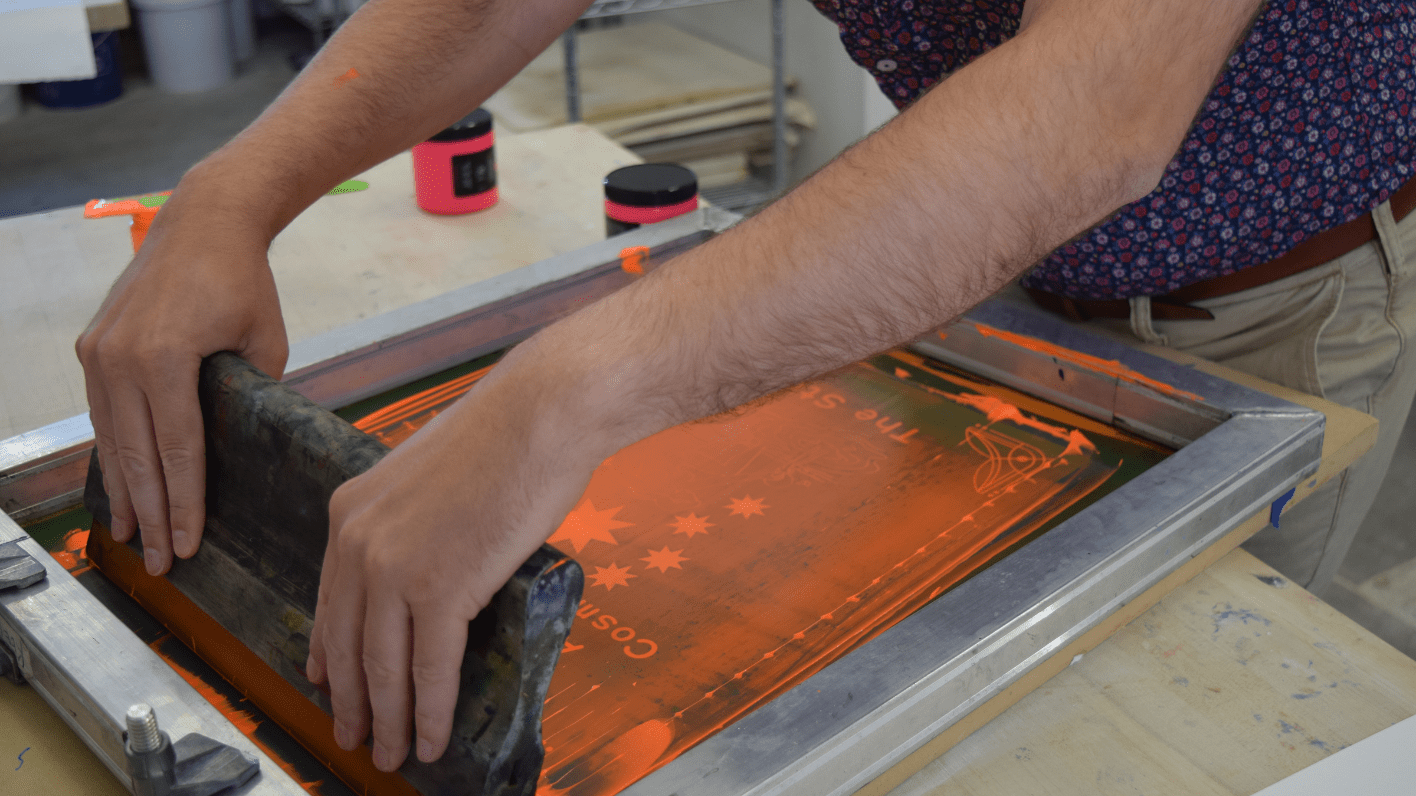From Layout to Distribution: Mastering the Art of T-Shirt Screen Printing
The trip from layout to shipment in t-shirt screen printing encompasses a series of vital stages that require focus to detail and strategic planning. It starts with comprehending the nuances of your target audience, complied with by the selection of ideal materials and the prep work of artwork that satisfies high requirements. As the procedure unravels, difficulties in high quality control and logistics can occur, potentially influencing the final outcome. Exploring these complexities reveals not just the intricacies of screen printing yet likewise the essential techniques that can raise a brand's standing in a competitive market.
Comprehending T-Shirt Screen Printing
Comprehending T-Shirt screen printing involves recognizing a functional and commonly utilized approach for moving designs onto textile. This method utilizes a stencil and a mesh screen to apply ink onto various fabric products, generally cotton and polyester blends. The process starts with the creation of a screen that features the preferred layout, which is after that meticulously aligned on the fabric.
Ink is pushed with the screen's open locations making use of a squeegee, permitting accurate application of shade. This approach is favored for its capability to create lively, durable prints that hold up well to washing and use. In addition, screen printing is qualified of fitting both easy and complicated layouts, making it a favored option for customized garments, promotional products, and also imaginative jobs.
Screen printing provides scalability, making it ideal for both small batch orders and large productions. While first configuration costs might be higher contrasted to other printing methods, the efficiency and longevity of screen printing commonly justify the financial investment. Generally, comprehending the principles of T-shirt screen printing is necessary for anyone aiming to take part in this preferred form of material design, whether for industrial endeavors or personal jobs.
Conceiving Your Design
Conceptualizing your style is a vital action in the Tees screen printing procedure, as it establishes the structure for the entire project (Screen Printing). This stage involves producing ideas that reverberate with your target market while making certain that the style lines up with the brand name's identity and message. It is necessary to start by exploring motifs, color pattern, and graphics that mirror the designated visual
Laying out initial concepts can be useful, enabling a graph of ideas prior to finalizing the style. Consider using typography, imagery, and design in a method that captures focus and communicates successfully. In enhancement, it is crucial to expect the printing method that will be employed, as this can affect layout complexity and color choices.
Taking part in conceptualizing sessions with group participants or seeking responses from possible consumers can likewise enhance the concept process, offering diverse perspectives that improve the design. Ultimately, a well-balanced design not just enhances the visual appeal of the Tees yet likewise cultivates a link with the target market, driving rate of interest and possible sales. For that reason, devoting time to conceive your layout can lead to a successful screen printing result.
Picking the Right Products

The weight of the textile, usually gauged in grams per square meter (GSM), affects the drape and general feel of the Tee shirts. Much heavier materials might offer a much more premium appearance, while lighter options fit for informal wear. Texture additionally plays a function; smoother materials often tend to produce sharper prints, while distinctive surfaces can produce special aesthetic effects.
Furthermore, think about the environmental influence of products. Organic cotton and recycled polyester are gaining popularity amongst eco-conscious customers. Inevitably, picking the appropriate products includes balancing visual charm, performance, and sustainability, making sure that the T-shirt not only looks wonderful yet additionally meets the expectations of your target market.
Preparing Art Work for Printing
Preparing art work for T-shirt screen printing needs mindful attention to detail to assure that the final print properly shows the designated layout. The very first step is to create a high-resolution electronic documents, ideally in vector format, as this allows for scalability without loss of high quality. Usual software program used for this objective consists of Adobe Illustrator and CorelDRAW.
Next, validate that all text is converted to outlines or rasterized to prevent font issues throughout printing (Business Branding Services Abilene). In addition, it is vital to validate that the color setting is established to CMYK, as this aligns with the printing procedure. Pay very close attention to shade matching; making use of Pantone colors can assist attain consistency throughout different prints
Consider the measurements of the print location and keep appropriate margins to stay clear of design cutoff. It's likewise important to consist of registration marks for positioning throughout the printing procedure. Business Branding Services. Request an evidence from the printer to envision the final product before mass manufacturing. This step is moved here important for identifying any kind of possible concerns, guaranteeing that the printed Tee shirts fulfills the wanted top quality and design specifications. Appropriate prep work of artwork considerably influences the total success of the screen printing task
Grasping the Printing Process
Mastering the printing procedure is crucial for attaining high-quality outcomes in Tee shirts screen printing. This phase involves numerous substantial steps that directly affect the end product. The first step is establishing up the printing machine accurately. Correct enrollment of displays guarantees that shades line up correctly, avoiding misprints and ensuring a professional appearance.
Next, choosing the appropriate ink is important. Various ink types, such as plastisol or water-based, deal different finishes and longevity. Comprehending the fabric make-up of the Tees likewise helps in choosing compatible inks.
When it involves the actual printing, managing the squeegee stress and angle is critical. Consistent pressure will certainly yield even ink distribution, while the angle influences the flow and protection. Additionally, readjusting the speed of the printing press can impact the ink's treating procedure, which is basic for assuring longevity.
High Quality Control and Finishing
After the printing procedure is full, executing reliable quality control steps ends up being essential to confirm that each T-shirt meets the preferred requirements. Quality assurance includes an organized approach to examining each garment for flaws, confirming that the print top quality, shade precision, and material stability straighten with the specifications established throughout the style stage.

The initial step in top quality control is a comprehensive aesthetic evaluation. This entails monitoring for typical problems such as misalignment, ink spots, or fading. Any kind of Tees that does not satisfy the quality criteria need to be dealt with promptly, either via reprinting or fixing.
In enhancement to visual checks, it is necessary to perform laundry examinations on an example of published tee shirts to evaluate the sturdiness of the inks and the overall long life of the style. These tests aid confirm that the print will maintain its vibrancy and stability after multiple laundries, a vital aspect for customer satisfaction.
Completing touches, such as string trimming and the application of treatment labels, additionally play a substantial role in high quality control - Screen Printing. By concentrating on these facets, companies can boost the general discussion of their products, eventually bring about a much more rewarding consumer experience
Product Packaging and Delivery Solutions

To attain optimal packaging, think about making use of green products that align with sustainability patterns, such as recyclable poly bags or biodegradable boxes. Each Tee shirts should be nicely folded and placed in safety covering to avoid creasing and possible damage throughout transportation. Including a top quality insert or treatment guidelines can even more individualize the experience, cultivating customer loyalty.
Choosing a dependable delivery companion is crucial when it comes to shipment. Review choices based upon rate, monitoring, and cost capacities. Providing numerous delivery methods can satisfy different consumer demands, from basic to expedited delivery.
Regularly Asked Inquiries
What Are the Usual Errors Novices Make in Screen Printing?
Common mistakes newbies make in screen printing consist of inappropriate screen prep work, poor ink blending, wrong direct exposure times, not enough healing, and disregarding to examine prints. These mistakes can cause bad high quality and unacceptable cause end products.
Exactly How Can I Avoid Ink From Bleeding Throughout Printing?
To stop ink blood loss throughout printing, assurance proper screen stress, use suitable emulsion density, choose the right ink uniformity, preserve perfect curing temperature levels, and prevent overloading the screen with too much ink throughout application.
What Kinds of Inks Are Finest for Different Fabrics?
Choosing inks based on fabric type is vital. Water-based inks are perfect for cotton, supplying gentleness. Plastisol inks match artificial materials, offering durability. Discharge inks properly blend with all-natural fibers, making sure dynamic shades without endangering fabric integrity.
Just how Do I Pick the Right Screen Mesh Count?
Picking the ideal screen mesh count depends upon the desired print information and ink kind. Abilene T-Shirt Screen Printing Company. Greater mesh counts produce better details, while lower counts help with thicker inks. Analyze textile type and design complexity for suitable outcomes
Can I Use Screen Printing for Small Batch Orders?
Yes, screen printing can be properly made use of for tiny batch orders. This technique permits high-quality results and detailed styles, making it a viable choice for personalized garments, advertising things, or minimal version runs.
Comprehending T-Shirt screen printing entails acknowledging a versatile and commonly used approach for transferring layouts onto material. While initial setup prices might be higher contrasted to various other printing techniques, the performance and sturdiness of screen printing usually warrant the investment. Preparing artwork for Tee shirts screen printing needs careful focus to information to ensure that the last print precisely reflects the designated style. Mastering the printing process is essential for accomplishing top quality results in Tee shirts screen printing. Common mistakes newbies make in screen printing include improper screen preparation, insufficient ink mixing, incorrect exposure times, inadequate curing, and disregarding to examine prints.